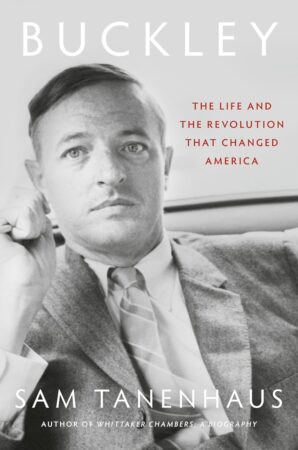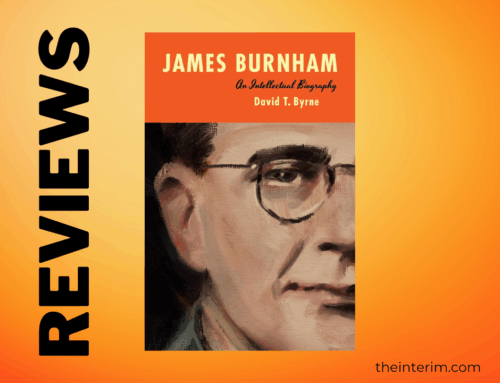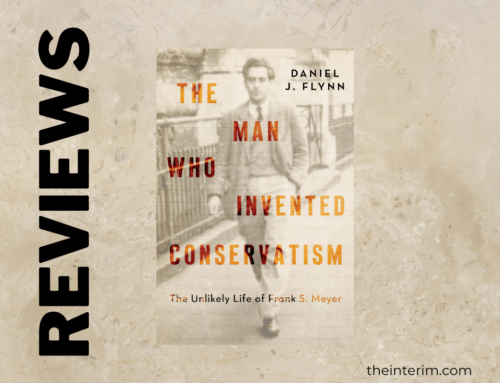Paul Tuns, Review:
Buckley: The Life and Revolution that Changed America by Sam Tanenhaus (Random House, $54, 1018 pages)
 The conservative columnist George F. Will says that before there was Ronald Reagan there was Barry Goldwater, that before that there was Goldwater there was National Review magazine, and before NR there was its founder William F. Buckley. Buckley was without doubt, the most influential journalist of the 20th century.
The conservative columnist George F. Will says that before there was Ronald Reagan there was Barry Goldwater, that before that there was Goldwater there was National Review magazine, and before NR there was its founder William F. Buckley. Buckley was without doubt, the most influential journalist of the 20th century.
Sam Tanenhaus, former editor of the left-wing New York Times Book Review, authorized Buckley to write his biography and gave him interviews and access to his papers. The result, Buckley: The Life and Revolution that Changed America, a doorstop of a book — more than 1000 pages, weighing more than three pounds — aspires to be the definitive treatment of Buckley’s life and career. The book was released in time for the centenary of Buckley’s birth 100 years ago this month, which also coincides with the 80th anniversary of the first issue of National Review.
Tanenhaus describes Buckley’s childhood and education. While the Buckley name is Irish Catholic, Buckley’s upbringing was more southern. He spoke Spanish and French in the home. The tales Tanenhaus tells of Buckley’s father and the influence he had on his son suggest that Tanenhaus should also write the biography of William F. Buckley Sr.
Buckley went to Yale, wrote a book about his experience in God and Man at Yale in 1951 at the precocious age of 25. Two years later, he co-founded the Intercollegiate Studies Institute and two years after that founded the magazine that gave intellectual vigour to a conservatism that the literary critic Lionel Trilling described as brain-dead. Not content to be a mere editor, Buckley would go on to help create Young Americans for Freedom and the Conservative Party of New York, conscript Barry Goldwater to run for president, run for mayor of New York City himself, launch a long-running public affairs program, make speeches across the country, and write thousands of opinion columns for syndication. Many of those columns were packaged as collections and they are among the approximately 60 books he published, including fiction. Buckley died at the age of 82 in office, writing.
His mayoral candidacy began with a typical Buckley witticism; when asked what he would do if he won the election Buckley replied, “demand a recount.” The campaign showed Buckley was personable and popular, and it led to him getting a show on PBS, the long-running Firing Line, which began in 1966 and ran under his droll questioning of guests for 33 years (more than 1500 episodes). Wherever there were converts to be won for conservatism, Buckley was there.
Tanenhaus depicts Buckley as both naturally talented and a hard worker. He had style and charm aplenty. All of it contributed to his influence as a conservative intellectual and doer.
The problem with Tanenhaus’s biography is that even coming in at more than 1000 pages, it seems abbreviated. The final 34 years of Buckley’s life, after Reagan was elected president, get jammed into about 100 pages. It is an understatement to say that Buckley’s final three and half decades is rushed.
At the same time, Tanenhaus sometimes goes on tangents about the broader conservative movement and seems to forget his subject. One particular case is an act worthy of high school debate but not a book that aspires to be the definitive biography of a man: Tanenhaus smears Buckley by association separated by several degrees, linking him through his brother who was elected a Conservative U.S. senator and who worked closely with Republican Senator Jesse Helms. The problem, in Tanenhaus’s telling, is that Helms is alleged to have been involved in some nasty racial politics decades previously. The implication is that the Buckleys themselves could be racist even though Tanenhaus admits that the Helms allegations are unproven. But does a decades-old local North Carolina political incident really have anything to do with William and James Buckley in the 1970s? Not really. Tanenhaus resorts to such smears against Buckley regularly, saying more about the author’s conventional liberalism than it does the author’s subject.
Those irrelevant digressions led to certain omissions, and not merely the condensed version of Buckley’s last three and half decades. Buckley’s wife Patricia and son Christopher are scarcely mentioned. Patricia Buckley’s wealth permitted Buckley a certain cache among the Manhattan and Swiss party set. How Buckley went from conservative agitator to star of New York cocktail parties needs to be explored. Pat Buckley suffered an ectopic pregnancy that left her infertile. Considering Buckley’s Catholicism, social conservatism, and pro-life sensibility, it might have been fruitful to explore Buckley’s marriage and family life.
Tanenhaus’s priorities include the mid-century Civil Rights Movement, which Buckley opposed. But because Tanenhaus views conservatism as little more than white backlash, he never seriously treats the issues that Buckley, National Review, the conservative movement, and Republican candidates rode to popularity: Cold War hawkishness against communism, concern with rising crime and welfare dependency, high taxes and loose money, and social unrest, including unease with the fruits of the Sexual Revolution. There is a rich reservoir of material from Buckley’s writings, speeches, and television shows, as well as other National Review writers and editors, on all these topics that Tanenhaus ignores or downplays because it does not fit his liberal worldview.
The fact is Buckley’s views on these topics aligned with the three legs holding up the stool of American conservatism: a strong foreign policy, economic freedom, and social conservatism. Buckley’s social conservatism hardly comes into play at all in Tanenhaus’s biography, yet the conservative leader wrote extensively about abortion, birth control, family breakdown, feminism, and religion. With a former NR employee, Jim McFadden, Buckley co-founded The Human Life Review to republish pro-life writings that first appeared in newspapers and magazines.
Buckley was famously – or infamously – a gatekeeper who sought to make conservatism both winsome and respectable. His effective defenestration of the conspiratorial John Birch Society is well-covered by Tanenhaus but not his fight against anti-Semitism within the Right, treated in a full magazine-length article and later published in book form. Buckley movingly writes about his own family’s history with anti-Semitism before charging the likes of Patrick Buchanan and Joe Sobran with not so much as being anti-Semitic as saying anti-Semitic things. The distinction was too fine for many, including Sobran, who was at the time an editor at NR. He would leave the magazine shortly after.
In fairness, to Tanenhaus, he succeeds in depicting Buckley’s capacities for generosity, friendship, wit, and finding talented young conservatives.
The question is whether Tanenhaus has indeed written the definitive biography of William F. Buckley Jr. The answer, quite remarkably, is that despite giving his subject a lengthy tome of a biography there is too much missing from the Buckley story, whether it is mining family life or covering Buckley’s career and influence from the early 1980s through his death in 2007. None of that is to say that reading is not rewarding. Buckley lived a fascinating life, moving from conservative outsider to Republican Party insider. The former made the latter possible because as the outsider, Buckley worked relentlessly to make conservatism not merely respectable but mainstream. Sometimes that involved policing the extremes of the movement, but more often it simply meant making the argument and winning it. More often than not, Buckley made the argument, in both style and substance, and won. Tanenhaus is excellent at depicting Buckley’s performances, a key part of his success. He writes of Buckley’s speeches in legion halls and Knights of Columbus meetings, that the young conservative with carefully parsed sentences and a rich vocabulary left his audience “mesmerized” even if people “couldn’t follow the thread of his arguments” because he was entertaining; he was a “spectacle.”
In an important way, Buckley would not be fashionable today, even if two of the three foundational legs of modern conservatism had not been hacked off by Make America Great Again conservatism. His deliberate effect would likely not work in the age of social media. More importantly, he gave conservatives the “Buckley Rule” when he stated, “I’d be for the most right, viable candidate who could win it.” While lacking in precision, it was a good guideline for conservatives deciding among candidates to support. The Buckley Rule looks like too much compromise for the highly polarized politics of the 2020s, even though, over time, it moved the Republican Party and conservative movement rightward. Not only did Ronald Reagan win in 1980, so did Buckley’s brand of conservatism.
Reading Buckley: The Life and Revolution that Changed America it is worth pondering whether Canadian conservatism was handicapped by not having its own version of William Buckley to do the intellectual heavy-lifting and entrepreneurial legwork to make conservatism succeed.




